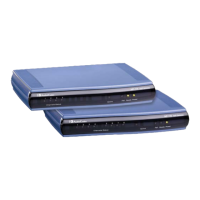Version 7.2 1105 Mediant 1000B Gateway & E-SBC
User's Manual 62. Configuration Parameters Reference
Parameter Description
and is applicable only when one of these protocols are used:
PSTN Protocol Transfer Method (Described Below)
E1 Euro ISDN [1] ECT [2] or InBand [5]
E1 QSIG [21],
T1 QSIG [23]
Single Step Transfer [4], Path
Replacement Transfer [2], or InBand [5]
T1 NI2 ISDN [10],
T1 4ESS ISDN [11],
T1 5ESS 9 ISDN [12]
TBCT [2] or InBand [5]
T1 DMS-100 ISDN [14] RTL [2] or InBand [5]
T1 RAW CAS [3], T1
CAS [2], E1 CAS [8], E1
RAW CAS [9]
[1] CAS NFA DMS-100 or [3] CAS
Normal transfer
T1 DMS-100 Meridian
ISDN [35]
RTL [2] or InBand [5]
The valid values of the parameter are described below:
[0] = Not supported (default).
[1] = Supports CAS NFA DMS-100 transfer. When a SIP REFER
message is received, the device performs a Blind Transfer by
executing a CAS Wink, waits for an acknowledged Wink from the
remote side, dials the Refer-to number to the switch, and then
releases the call.
Note: A specific NFA CAS table is required.
[2] = Supports ISDN PRI/BRI transfer - Release Link Trunk (RLT)
(DMS-100), Two B Channel Transfer (TBCT) (NI2), Explicit Call
Transfer (ECT) (EURO ISDN), and Path Replacement (QSIG).
When a SIP REFER message is received, the device performs a
transfer by sending Facility messages to the PBX with the
necessary information on the call's legs to be connected. The
different ISDN variants use slightly different methods (using
Facility messages) to perform the transfer.
Note:
For RLT ISDN transfer, the parameter
SendISDNTransferOnConnect must be set to 1.
The parameter SendISDNTransferOnConnect can be used to
define if the TBCT/ECT transfer is performed after receipt of
Alerting or Connect messages. For RLT, the transfer is always
done after receipt of Connect (SendISDNTransferOnConnect
is set to 1).
This transfer can be performed between B-channels from
different trunks or Trunk Groups, by using the parameter
EnableTransferAcrossTrunkGroups.
The device initiates the ECT process after receiving a SIP
REFER message only for trunks that are configured to User
side.
[3] = Supports CAS Normal transfer. When a SIP REFER
message is received, the device performs a Blind Transfer by
executing a CAS Wink, dialing the Refer-to number to the switch,
and then releasing the call.

